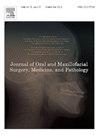Dentoalveolar distraction osteogenesis combined with surgical orthodonthic treatment for a patient with jaw deformity and ankylosed maxillary canine – A case report
IF 0.4
Q4 DENTISTRY, ORAL SURGERY & MEDICINE
Journal of Oral and Maxillofacial Surgery Medicine and Pathology
Pub Date : 2024-06-24
DOI:10.1016/j.ajoms.2024.06.007
引用次数: 0
Abstract
In surgical orthodontic treatment, the presence of an ankylosed tooth makes it difficult to achieve the desired dental arch morphology. Single tooth osteotomy and dentoalveolar distraction osteogenesis (DO) combined with surgical orthodontic treatment for a patient with jaw deformity and an ankylosed maxillary canine is described in this report. A 37-year-old female was referred to our clinic with a chief complaint of anterior crossbite and was diagnosed with skeletal mandibular protrusion. During preoperative orthodontic treatment for surgical orthodontic treatment, her upper right canine did not move and was diagnosed as an ankylosed tooth. Therefore, we decided to perform a single tooth osteotomy and dentoalveolar DO of the right maxillary canine. Instead of using a commercially available distractor, the dentoalveolar DO in this case was performed using a homemade device with orthodontic biomechanics to move the ankylosed tooth with its supporting alveolar bone and soft tissue into the correct position. After preoperative orthodontic treatment, orthognathic surgery with Le Fort I osteotomy and bilateral sagittal split osteotomies was performed. However, root resorption of the right upper canine continued, and the resorption area was therefore restored with composite resin 10 months after orthognathic surgery to improve the function and esthetics of the maxillofacial region. One and a half years have passed since the orthognathic surgery, and the skeletal stability is good, and the patient is progressing well.
牙槽骨牵引成骨联合外科正畸治疗一名下颌畸形和上颌犬牙强直的患者--病例报告
在外科正畸治疗中,由于强直牙的存在,很难达到理想的牙弓形态。本报告描述了对一名患有颌骨畸形和上颌犬牙强直的患者进行单牙截骨术和牙槽骨牵引成骨术(DO)结合外科正畸治疗的情况。一名 37 岁的女性因主诉前交叉咬合而被转诊至我院,并被诊断为下颌骨骼前突。在进行外科正畸治疗的术前正畸治疗期间,她的右上犬齿没有移动,被诊断为强直牙。因此,我们决定对右侧上颌犬齿进行单牙截骨和牙槽骨 DO。在这个病例中,我们没有使用市面上销售的牵引器,而是使用一种自制的具有正畸生物力学原理的装置来进行牙槽骨DO,从而将强直牙及其支持的牙槽骨和软组织移动到正确的位置。术前正畸治疗后,进行了正颌外科手术,包括 Le Fort I 截骨术和双侧矢状劈开截骨术。然而,右上犬齿的牙根吸收仍在继续,因此在正颌手术 10 个月后用复合树脂修复了吸收区,以改善颌面部的功能和美观。正颌手术后一年半过去了,患者的骨骼稳定性良好,进展顺利。
本文章由计算机程序翻译,如有差异,请以英文原文为准。
求助全文
约1分钟内获得全文
求助全文
来源期刊

Journal of Oral and Maxillofacial Surgery Medicine and Pathology
DENTISTRY, ORAL SURGERY & MEDICINE-
CiteScore
0.80
自引率
0.00%
发文量
129
审稿时长
83 days
 求助内容:
求助内容: 应助结果提醒方式:
应助结果提醒方式:


